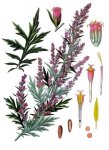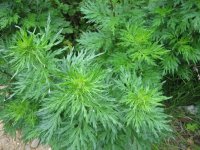Wormwood
Artemisia vulgaris L.
Botanical characteristics. Family Compositae. Perennial herbaceous plant with dense stem, densely branched at the top, about 1 m high. Leaves regular, pinnately divided and whole, color dark green on top, gray below. Ungainly tubular flowers, collected in long panicles, densely dot the stalk. Blooms in July-August, fructifies in August-September.
Spread. It is widely distributed almost throughout the whole territory of our country. It grows on weedy places, along roads, on the banks of streams and small rivers.
Used parts of the plant.
Layered apexes collected at the beginning of flowering; In autumn - roots.
The bitter taste of wormwood, as well as its antiseptic and anti-inflammatory effect, are due to the presence of absintine and anabsintine in it.
It is used as a general restorative, anti-inflammatory, antiseptic and antipyretic.
Infusions of herbs are prescribed for neuroses, epilepsy, thyrotoxicosis, migraine, meningitis and neuroinfections. As a restorative and appetite-improving hoodoo is shown for pulmonary tuberculosis, obturation bronchitis and bronchiectasis.
Add to the fees for gastrointestinal diseases, liver diseases, cholelithiasis. The Chernobylnik has an antitumor effect and is included in Zdrenko's collection.
Fresh grass is applied to the wounds for more rapid healing.
Contraindications. Pregnancy.
Preparation. Insist 2 tablespoons per 0.5 liters of boiling water - daily dose.
In homeopathy apply Artemisia vulgaris 3x, 3, 6 with epilepsy, accompanied by large and small seizures, in ophthalmic practice with asthenopia.





Comments
When commenting on, remember that the content and tone of your message can hurt the feelings of real people, show respect and tolerance to your interlocutors even if you do not share their opinion, your behavior in the conditions of freedom of expression and anonymity provided by the Internet, changes Not only virtual, but also the real world. All comments are hidden from the index, spam is controlled.